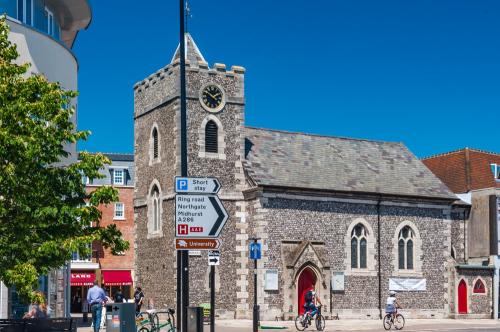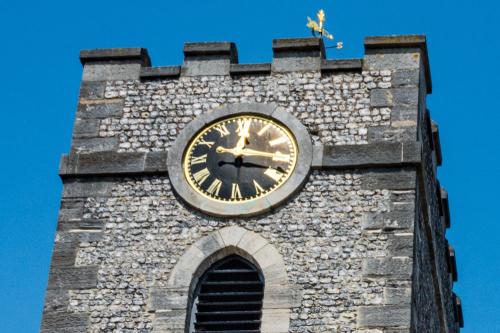
The Church of St Pancras is an 18th-century building just outside the medieval walls of historic Chichester, standing on the site of an earlier medieval church destroyed in the English Civil War. We know little about the original church, aside from the fact that its tower was used as a gun platform during the 1642 siege of Chichester.
History
The parish of St Pancras continued on after the Civil War, even though there was no longer a church, and the site was used for lumber storage.The present building was finally erected in 1750 under the supervision of William Ride, who served as surveyor to the Duke of Richmond at nearby Goodwood House.
The project was made possible through generous patronage, with Mary, Countess of Derby contributing £400 and the Duke of Richmond donating £105. The Georgian church would later undergo significant Victorian modifications and extensions under the direction of architect Gordon M Hills in 1868-69, which dramatically increased its capacity from 134 to 314 seats. The most recent addition came around 1990 with the construction of parish rooms.
The site on which the church stands is small, and the building butts up against its neighbours to the east, resulting in a very short chancel with circular side windows. By contrast, the tower is almost the full width of the nave. The original church entrance was throug the tower, but it was later moved to a stubby south porch facing onto Eastgate Square.
Architectural Features
The church is constructed from materials typical of Sussex architecture, combining knapped flint walls with freestone dressings and slate roofs. Its design represents an intriguing blend of Classical and Gothic elements. The exterior features an unbuttressed nave with a Classical pediment decorated with stone dentils, while Gothic influences can be seen in the Perpendicular-style windows on the south side.
The west tower, though small and low, is a notable feature with its embattled parapet, pyramidal roof, and large lancet windows in the belfry. A distinctive wide projecting stair turret on the northeast corner may be a later addition. The church's northern aisle, added during the Victorian renovation, displays windows in the Decorated Gothic style.

Interior Design and Fixtures
The interior largely reflects the 1868-69 restoration work by GM Hills, who added the north aisle because it was the only direction that the church could be extended. Interior features include:
- A two-bay arcade with uniquely sectioned piers
- A 19th-century chancel ceiling with canted sides and moulded ribs
- A nave roof that combines 18th-century classical queen posts with Victorian modifications
- A west gallery inserted in 1806 and rebuilt in 1869
- A 1900 reredos featuring the HIS monogram and panels containing the Creed, Lord's Prayer, and Ten Commandments
- 18th-century painted armorial glass by Tremaine, displaying the arms of the church's principal benefactors, the Duke of Richmond and the Duchess of Derby
- 19th-century octagonal font
- 1869 organ gallery over the tower arch
Setting and Context
Unlike many churches, St Pancras has no churchyard and is tightly integrated into the urban fabric of Chichester, surrounded by streets and buildings. This unusual setting reflects its historical position just outside the medieval town walls and its development within an evolving cityscape.
Heritage Significance
The church holds Grade II listed status, recognized for three principal reasons: its identity as a mid-18th century town church that underwent significant Victorian alterations, its remarkable history encompassing Civil War destruction, Georgian rebuilding, and Victorian enhancement, and its architectural merit in successfully combining Classical and Gothic elements using traditional Sussex building materials.
Today, it stands as both an active place of worship and a valuable piece of Chichester's architectural heritage.
Visiting
To the best of our knowledge, St Pancras Church is not normally open to visitors, but they do welcome people to Sunday services. It is simplicity itself to see the church exterior; it stands at the eastern end of East Street, a short stroll from the cathedral and city centre.
About Chichester, St Pancras Church
Address: East Gate,
West Sussex,
England, PO19 7LJ
Attraction Type: Historic Church
Location: At the junction of East Street and St Pancras road, a short stroll from the city centre.
Website: Chichester, St Pancras Church
Location
map
OS: SU864048
Photo Credit: David Ross and Britain Express
POPULAR POSTS
HERITAGE
 We've 'tagged' this attraction information to help you find related historic attractions and learn more about major time periods mentioned.
We've 'tagged' this attraction information to help you find related historic attractions and learn more about major time periods mentioned.
Historic Time Periods:
Find other attractions tagged with:
18th century (Time Period) - Civil War (Architecture) - Georgian (Time Period) - Victorian (Time Period) -
NEARBY HISTORIC ATTRACTIONS
Heritage Rated from 1- 5 (low to exceptional) on historic interest
Litten War Memorial Gardens - 0.1 miles (Garden) ![]()
Chichester, St John the Evangelist - 0.1 miles (Historic Church) ![]()
Chichester Roman Amphitheatre - 0.1 miles (Roman Site) ![]()
Pallant House Gallery - 0.2 miles (Museum) ![]()
St Mary's Hospital Almshouses - 0.2 miles (Historic Building) ![]()
Chichester Roman City Walls - 0.2 miles (Roman Site) ![]()
Chichester Guildhall - 0.2 miles (Historic Church) ![]()
Chichester, St Olave's Church - 0.2 miles (Historic Church) ![]()
Nearest Holiday Cottages to Chichester, St Pancras Church:
Runcton, West Sussex
Sleeps: 6
Stay from: £532 - 1946
More self catering near Chichester, St Pancras Church



